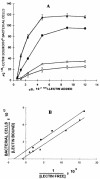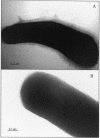Effects of iron limitation on adherence and cell surface carbohydrates of Corynebacterium diphtheriae strains
- PMID: 14532043
- PMCID: PMC201255
- DOI: 10.1128/AEM.69.10.5907-5913.2003
Effects of iron limitation on adherence and cell surface carbohydrates of Corynebacterium diphtheriae strains
Abstract
Iron limitation may cause bacterial pathogens to grow more slowly; however, it may also stimulate these microorganisms to produce greater tissue damage, given that many virulence factors are controlled by the iron supply in the environment. The present study investigated the influence of low iron availability on the expression of proteins and surface sugar residues of two toxigenic strains of Corynebacterium diphtheriae subsp. mitis and evaluated their adherence to human group B erythrocytes and HEp-2 cells. A comparison was made between bacteria grown in (i) Trypticase soy broth (TSB), (ii) TSB treated with dipyridyl to deplete free iron, and (iii) TSB enriched with FeCl(3). The effects of iron concentration on adhesive properties were different for strains 241 and CDC-E8392, of the sucrose-fermenting and non-sucrose-fermenting biotypes, respectively. Iron-limited conditions enhanced interaction of strain 241 with erythrocytes and HEp-2 cells. Inhibition assays suggested the involvement of nonfimbrial protein combination 67-72p on hemagglutination of diphtheria bacilli grown under iron-limited conditions. Conversely, iron limitation inhibited adherence to glass and expression of electron-dense material on the bacterial surface. Lectin binding assays demonstrated a reduction in the number of sialic acid residues and an increase in D-mannose and D-galactose residues on the surfaces of both strains. Thus, iron exerts a regulatory role on adhesive properties of diphtheria bacilli, and low iron availability modulates the expression of C. diphtheriae surface carbohydrate moieties. The significant changes in the degree of lectin binding specific for D-mannose, D-galactose and sialic acid residues may have an effect on binding of host cells. The expression of dissimilar microbial virulence determinants may be coordinately controlled by common regulatory systems. For C. diphtheriae, the present results imply regulation of adherence and slime production as part of a global response to iron-limited environmental conditions that includes derepression of genes for the synthesis of cytotoxin and siderophores and for transport of the Fe(III)-siderophore complexes.
Figures



Similar articles
-
Influence of stannous chloride on the adhesive properties of Corynebacterium diphtheriae strains.Int J Mol Med. 2003 Oct;12(4):657-61. Int J Mol Med. 2003. PMID: 12964050
-
Relationship of biotype and source to the hemagglutination and adhesive properties of C. diphtheriae.Braz J Med Biol Res. 1991;24(4):399-406. Braz J Med Biol Res. 1991. PMID: 1823253
-
Cell surface hydrophobicity of sucrose fermenting and nonfermenting Corynebacterium diphtheriae strains evaluated by different methods.Curr Microbiol. 1999 Jan;38(1):37-42. doi: 10.1007/pl00006769. Curr Microbiol. 1999. PMID: 9841780
-
Cell surface components and adhesion in Corynebacterium diphtheriae.Microbes Infect. 2000 Oct;2(12):1507-12. doi: 10.1016/s1286-4579(00)01305-8. Microbes Infect. 2000. PMID: 11099937 Review.
-
[Adhesion of corynebacterium diphtheriae: the role of surface structures and formation mechanism].Zh Mikrobiol Epidemiol Immunobiol. 2014 Jul-Aug;(4):109-17. Zh Mikrobiol Epidemiol Immunobiol. 2014. PMID: 25286540 Review. Russian.
Cited by
-
Iron-regulated surface determinant (Isd) proteins of Staphylococcus lugdunensis.J Bacteriol. 2012 Dec;194(23):6453-67. doi: 10.1128/JB.01195-12. Epub 2012 Sep 21. J Bacteriol. 2012. PMID: 23002220 Free PMC article.
-
Corynebacterium diphtheriae employs specific minor pilins to target human pharyngeal epithelial cells.Mol Microbiol. 2007 Apr;64(1):111-24. doi: 10.1111/j.1365-2958.2007.05630.x. Mol Microbiol. 2007. PMID: 17376076 Free PMC article.
-
Iron-dependent gene expression in Actinomyces oris.J Oral Microbiol. 2015 Dec 16;7:29800. doi: 10.3402/jom.v7.29800. eCollection 2015. J Oral Microbiol. 2015. PMID: 26685151 Free PMC article.
-
Corynebacterium diphtheriae invasion-associated protein (DIP1281) is involved in cell surface organization, adhesion and internalization in epithelial cells.BMC Microbiol. 2010 Jan 5;10:2. doi: 10.1186/1471-2180-10-2. BMC Microbiol. 2010. PMID: 20051108 Free PMC article.
-
Cigarette Smoke Particle-Induced Lung Injury and Iron Homeostasis.Int J Chron Obstruct Pulmon Dis. 2022 Jan 12;17:117-140. doi: 10.2147/COPD.S337354. eCollection 2022. Int J Chron Obstruct Pulmon Dis. 2022. PMID: 35046648 Free PMC article. Review.
References
-
- Baldassari, L., L. Bertuccini, C. R. Ammendolia, C. R. Ariciola, and L. Montanaro. 2001. Effect of iron limitation on slime production by Staphylococcus aureus. Eur. J. Clin. Microbiol. Infect. Dis. 20:343-345. - PubMed
-
- Bullen, J. J. 1985. Iron and infection. Eur. J. Clin. Microbiol. 4:537-539. - PubMed
-
- Carniel, E. 2001. The Yersinia high-pathogenicity island: an iron-uptake island. Microbes Infect. 3:561-569. - PubMed
-
- Colombo, A. V., R. Hirata, Jr., C. M. R. Souza, L. H. Monteiro-Leal, J. O. Previato, L. C. D. Formiga, A. F. B. Andrade, and A. L. Mattos-Guaraldi. 2001. Corynebacterium diphtheriae surface protein as adhesin to human erythrocytes. FEMS Microbiol. Lett. 197:235-239. - PubMed
Publication types
MeSH terms
Substances
LinkOut - more resources
Full Text Sources
Medical

